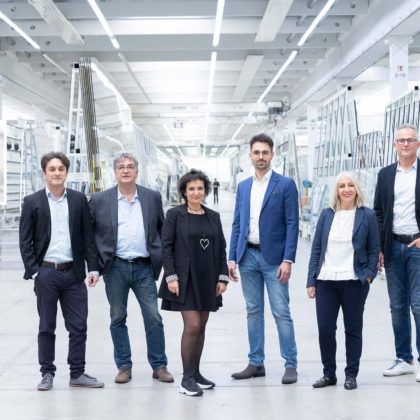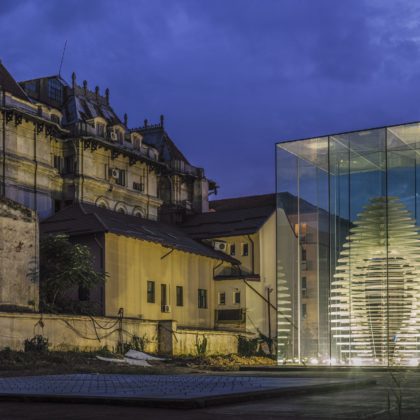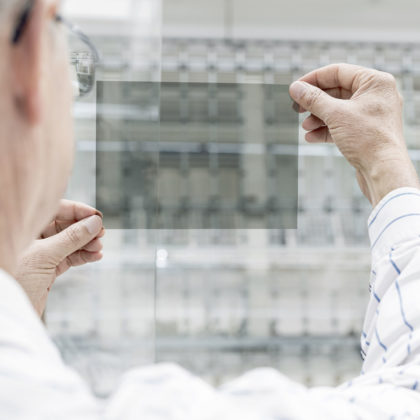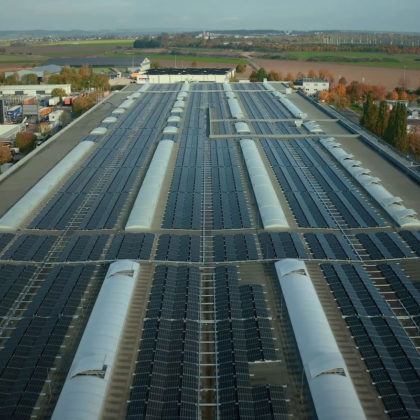sedak secudecor / sedak isodecor: Secure or insulating – and always individually designable!
New digital printer for brilliant high-precision glass production up to 16.5m
Functionality and esthetics of oversize glass – that is what the two product lines sedak isodecor and sedak secudecor unite. The insulating and safety glass units are printed with ceramic inks and fulfill decorative and functional requirements (sight protection/ solar protection) up to 3.2m x 16.5m. With a new, highly modern flatbed printer, sedak achieves particular brilliance with a resolution of up to 1024 dpi. The “House of European History” in Brussels impressively shows which design options the ceramic-ink digital printer offers to architects and how functionality and esthetics form a harmonious result.
Due to the new, large-size ceramic-ink digital printer, sedak gives fanciful designing further space. The high-precision printer applies the colors in a resolution up to 1024 dpi. Thus, complex, multi-color grid designs, ornaments, or imitated material structures can be printed very accurately. Large-size, photorealistic scenes are also possible. Since the applied layer of color is thinner than with screen printing, the technique allows for translucence and fluent transitions. The automated printing process allows for an extremely economic production and hence for a cost-efficient, individual façade designing. Afterwards, the glass is being tempered in sedak’s furnace. During that process, the ceramic inks are permanently bonded to the surface and therefore resistant to scratches.
The decorative component opens a creative world, especially when designing functional façades. By e.g. printing the surface partially, selected areas provide shade, and sun and glare protection is realized. That even offers the chance for a solution without sunshade systems which meets the demand for both esthetics and economic efficiency. Defined parts can also function as sight protection.
sedak processes the printed glass into insulating and safety glass. The IGU sedak isodecor is manufactured as standard double or triple units, the safety glass sedak secudecor is available in multi-layer set-ups depending on safety requirements. Both products are fabricated in dimensions up to 3.2m x 16.5m.
Printing know-how: brilliant and fast
Operating a second printer now, sedak introduces a quality leap for photorealistic prints on oversize glass. The scenes reach highest brilliance in less time, which makes this production step more economical. The machine produces easily “batch size 1” and allows for maximum creative flexibility. By using ceramic inks, the result is resistant to UV radiation, also when exposed to high solar radiation.
The decision to operate a digital printer is closely linked to the specialization in oversize dimensions. Screen printing is limited to about eight meters. Digital printing is not only faster (comparing one print run for all colors to the single color application with screen printing) but, above all, far more efficient when many different designs are demanded since no screens are necessary.
The precision of the printer is particularly impressive for double-vision designs. “This technique requires two printings, one on top of the other, positioned absolutely exactly. To manage this, the glass has to be moved exactly to its initial position after the first print run has dried,” explains Ulrich Theisen, General Manager and Sales Director of sedak. That is precision work based on a perfect facility and experienced employees. The image can be applied in different colors, e.g. white on the outside and grey on the inside.
House of European History in Brussels
The Eastman Building is an example for the perfect symbiosis of functionality and creative design realized with the ceramic-ink digital printer. The former dental clinic is located in Leopold Park, at the heart of the European Quarter of Brussels. Over the last years, Chaix & Morel et Associés, Paris and JSWD Architekten redesigned the building to accommodate the “House of European History”. Originally constructed in the 1930s, it was now to receive a glass “implant”. The exhibition boxes inside the glazed volume are arranged freely and purposely placed in contrast to the symmetry of the older building.
A large part of the glass envelope is formed by 53 glass units and 168 glass fins in total. The layers of the 4- and 6-layer glass-fin laminates had been shifted, so that the fins could interlock. To connect the 13.8m long fins with the printed glass units and the roof, sedak SG bonded stainless steel profiles at its factory. In order to ensure a safe installation, the double, up to 7.8m long laminates used for the façade were SG bonded with two stainless steel profiles.
Each façade unit and each glass fin was manufactured individually and for different façade sides. It was a major challenge for sedak to produce the elements in the right order so that a punctual delivery and a smooth installation could be ensured.
The interplay of the existing building and the extension, and of day and night makes the ensemble especially appealing: During the day, the glass facade filters the light and the view; at night the envelope dissolves – the building shines.
Technical data: ceramic-ink printer
The new flatbed printer is a customized solution and, up to now, the largest printer for glass worldwide.
max. size: 3,200mm x 16,500mm
glass thickness: 6mm – 19mm
max. weight: 2,822 kg
type of color: ceramic-ink; heavy-metal free
precision: ± 20µm/m
coating: 6µm – 80µm
tolerances: ± 2mm (8mm – 9.000mm), ± 4mm (9.000mm – 18.000mm)
picture formats: PDF, PS, EPS, AI, TIFF, BMP, JPEG, DXF
resolution: up to 1024 dpi
 |
Free designing of insulating and safety glass in dimensions up to 16.5m: sedak offers more space to creative minds.
Photo: sedak GmbH & Co. KG | Photographer René Müller
|
||
 |
New high-performance printer with a resolution of 1024 dpi for an area of 3.2m x 16.5m: That creates brilliant pictures on glass. In comparison, a standard poster with dimensions of 2.52m x 3.56m is printed with a resolution between 80 and 120 dpi.
Photo: sedak GmbH & Co. KG
|
||
 |
The Eastman Building – so close to heaven: view from the inside up the façade. The glass fins are nearly 14m high.
Photo: sedak GmbH & Co. KG | Photographer: Christian Fabris
|
||
 |
Sight protection from outside, solar protection and decorative light inside. The white lines, applied accurately to a millimeter by the digital printer, perfectly unite esthetic and functional requirements.
Photo: sedak GmbH & Co. KG | Photographer: Christian Fabris
|
||
 |
Sight protection from outside, solar protection and decorative light inside. The white lines, applied accurately to a millimeter by the digital printer, perfectly unite esthetic and functional requirements.
Photo: sedak GmbH & Co. KG | Photographer: Christian Fabris
|
||
 |
At night, the “House of European History“ shines: The glass envelope and the existing historic building create a harmonious and exceptional unity.
Photo: sedak GmbH & Co. KG | Photographer: Christian Fabris
|
||
For more information please contact:
| sedak GmbH & Co. KG
Tatjana Vinkovic
|
|||
Reprint free of charge, copy requested
sedak GmbH & Co. KG
Leading glass
sedak, the glass manufacturer in Gersthofen, Germany, was founded in 2007. The company and its 150 employees have developed into the world’s technology and innovation leader for large insulating and safety glass. With a ten-year experience of manufacturing oversize glass and after having increased the level of automation continuously, sedak is regarded as a specialist in this know-how intensive segment. The glass units reach dimensions up to 3.2m x 16.5m – processed, tempered, laminated, printed, coated, and cold bent. The core capabilities are the lamination of glass, edging, and the company’s special knowledge of producing glass components with additional functional and decorative elements. sedak’s production has been optimized for extraordinary glass sizes and weights; all finishing steps are highly automated and handled in-house. As a full supplier for glass up to 16.5m, sedak sees itself as a partner for architects, designers, and façade constructors. Outstanding references are for example the House of European History in Brussels, the Faculty of Medicine in Montpellier, the Torre Europa in Madrid, Brookfield Place in New York City, the United Nations Office at Geneva, the Apple Cube in New York City, the science center experimenta in Heilbronn, as well as numerous premium flagship stores worldwide.
Applications
- glass façades
- glass roofs
- glass stairs
- glass balustrades
- ship building
- safety glazing
- all-glass constructions
- interior design
- custum-made glass units





